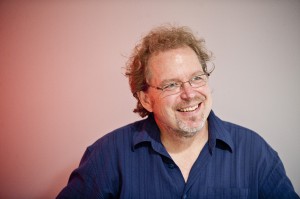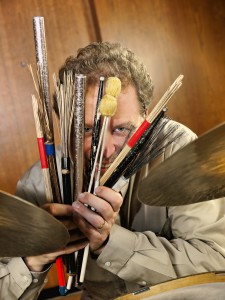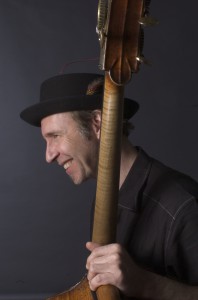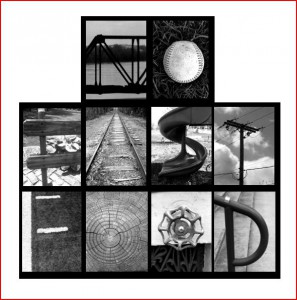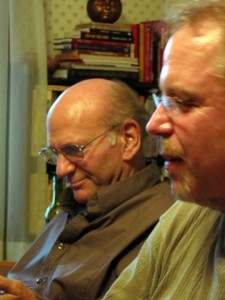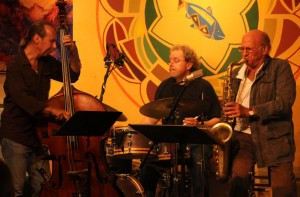PHIL – osophy
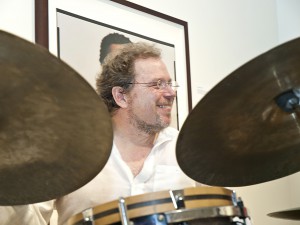 |
“ PHIL on PHIL ”
Q: Why even bother to make physical CDs anymore?
A: Oh gawd – dare I admit to audiophiles that I actually like them?
See, at least those that are being pressed in nice packaging, anyway, I can dig – but never with those dreaded jewel boxes! I truly appreciate a CD’s sound quality potential, tactile feel, and multi-page graphic art layouts.
Moreover, I love the challenge they present as an artistic medium. For instance, a select few volumes of short stories are actually more than the sum of their parts simply because of the sequence the selections have been placed in, where the author is able to tell an additional narrative, of a grander scope. Ditto for CDs. The custom has been to release 60-75 high quality minutes of listening per disc, as opposed to classic vinyl which was optimally designed for 30-36 total minutes – with a literal “break” in the middle as listeners flip sides. Without any physical breaks and with double the time commitment than an LP, compact discs challenge both audiences and artists – perhaps just as the introduction of the Symphony did two centuries ago. It’s no wonder that most commercial radio is still made up of 3-4 minute tune playlists.
Also, like any book or score, most of these are fine and more convenient as downloads. Some, however, I still want to own in paperback. Fewer still, I really want a good hard copy edition – and then on rare occasions, I truly fantasize about owning a first edition.
Ditto for LP’s. While downloads and CD’s are often preferable, IF I have access to a great turntable & stereo, there is simply no substitute for the experience of a Bob Ludwig mastered & Rudy VanGelder recorded classic jazz date on good vintage vinyl, for instance. After all, the LP is the precise medium that our greatest artists of the 1950’s & ‘60’s were conceptualizing and recording upon For instance, John Coltrane’s “A Love Supreme” was clearly a through composed concept album performed and recorded for the listening experience only an LP can offer. Imagine, putting on that side to hear it for the first time. I mean, assuming you make it through side A and then flip the LP over — POW(!!!) — you are immediately confronted by an intense, thundering, drum solo that Elvin Jones bases upon the 12 bar form of “Pursuance”. It’s just never the same experience on CD.
Downloading individual tunes or favorite movements to one’s I-pod is fine, but if an artist you dig really has something to say, and it’s uniquely crafted and designed for the medium they initially published on, then there’s likely no substitute for owning and sharing the original.
Q: Why do your recording techniques/approaches sometimes run counter to the commercial norm?
A: I just prefer to hear the musician’s natural sound and blend as their ensemble interactions mingle — and it’s not coincidental —
as natural sound, blend, and inspired real-time interaction are co-dependent.
Understand first, there are no secrets. “My techniques” were learned from earlier masters in the field. For acoustic instruments, performed by true ensembles, I crave the authenticity that can be captured with a few great (and well selected) classic microphones, ideally placed, in a wonderful live space. For quiet to moderately full ensembles, such as a piano trio or a dynamically sensitive two horns, bass, and drums quartet, I prefer warm, live rooms, such as an exceptional recital hall or concert hall stage – using minimal close mic approaches for the piano & bass – without direct boxes. Then, adding perhaps a great stereo pair of Schoeps, hung a few feet over the drums, plus one for the bass drum.
A recording such as Steve Rudolph’s Day Dream was captured in the middle of Bucknell University’s Rooke Recital Hall stage, mostly with us set in a very tight triangle — microphones in the middle, pointing outward to each of us — without the use of any baffles nor even amplification on Drew Gress’ bass. If you are going to compose & record music intended to capture the nuances of a grand piano with acoustic bass and drum-set sonorities, it just doesn’t make to separate the instruments into their own rooms.
In a good sounding ‘live’ studio with an acoustically balanced ensemble, once you hand individual headphones to artists and give them their own little mixing boxes, you relinquish an acoustic ensemble’s balance, mix, timbre-al palate and combined resultant tones(!) to an engineer or producer who simply can not be as authentically nuanced as the actual live performers.
In such cases, you may have lost the war in favor of winning a few old battles.
Now, if you are planning for an all amplified “power trio” approach, it’s a different animal entirely- but then you are not looking for how the overtones of each acoustic instrument combine, blend, etc. I remember hearing Keith Jarrett’s piano trio a couple of times live, including at Carnegie Hall. I simply could never understand why Jack would play so loud such that they had to have a full sound crew w/stage monitors for each musician & loudspeaker stacks for the audience. I mean, concert halls generally sounds like total CRAP when approached like that – not to mention how acoustic bass suffers the most in the midst all of that amplification.
I’ll make everyone a nice, tasty deal: Play in a big, dry club, multi-booth studio, or a huge outdoor stage if you want to employ the pleasure, density & physicality of a true power trio.
Trust me. . . I do “get it” and I know first-hand: its simply indescribable fun and an awe inspiring RUSH to be a drummer able to really hit your kit. Not, however, when it’s at the cost of sensitivity to the sound, touch and blend the ensemble’s assembled acoustic instrumentalists have spent their entire lives refining – something that an un-amplified venue like Carnegie Hall would highlight.
Sometimes, I believe that we get so wrapped up in the process of documenting music, we simply forget ourselves in the midst of: “but that’s how everyone else does it”.
4 Horns & What, during our tours in the 90’s, actually got me back on track with regards to sound reinforcement, dynamics, etc. As we played clubs on those tours, we’d often not use their stages but instead set up “in the round” with our audiences intimately encircling us w/o PA’s. It was a rare and moving experience for all.
Later, we were featured at an Austrian jazz fest held at the Graz Opera House. The producer and promoters of the festival became aghast when I refused to do our sound check, or the performance, unless we were left totally “un-plugged”. While it was incredibly challenging dynamically as the drummer to play in such a tremendous, live hall, nevertheless, the ‘4 Horn Band’ won everyone over – including the producers as well as the infectious audience- as the quintet’s nuanced sounds, control & artistry could be clearly appreciated in that great hall.
On the other hand, when 4 Horns & What played for 10,000 at the Moers festival, it was a freakin’ total HOOT to bash the house down with Ellery, Andy, Herb & Paul blowing their faces off on that big stage utilizing an ideal sound design & crew. Now that’s some real hitting, ‘ya know!
Q: How do you suggest going about selecting a studio, an engineer, etc.?
A: Listen to your favorite sounding & feeling recordings, note their production techniques, then duplicate with colleagues you can “hear” will be able to deliver.
For me, an engineer is always the first priority – immediately following your music & musicians – as these specialists have more impact on how your date will feel and sound than any other variable, period. Everyone’s first criteria should be obvious: can the engineer faithfully capture each of our sounds, in that particular room, on that day – before adding reverb, etc. Without that, it’s gonna be a long date for all ye sound artists, ‘dig?
How many times have I gone to a sideman date w/a truly big/brand name commercial engineer and have the equally lauded producer inform me that I was about to have the best sound of my life, guaranteed, despite the fact neither of them had ever heard even one of my own recordings? Or instead, arrive at the studio to be asked by the unsuspecting hip young jazz engineer, “…Phil, how do you want your kit to sound – like Philly Joe, Elvin, Tony, or Jack?”. They all meant well, yet . . .
When I set out to record my debut, Continuum – The Passing, I knew I could neither afford Rudy VanGelder nor did I really even desire his sound for the project. So, how was I to choose(?), I decided to school myself. I went straight to my LP collection of mostly used & cutout purchases and pulled out my favorite sounding sides. Quickly, I found that other than VanGelder and ECM engineers, as of 1986 David Baker had recorded most of my favorites. Well, since I wasn’t yet traveling with Continuum to Europe, David was my first clear choice.
David Baker, as well as Jim Anderson, taught me so much about the art of recording acoustic musicians in dry studios and rooms, that by the time I met a young Jon Rosenberg some twenty-five years ago, we were able to communicate and teach each other rapidly. I’ve not had occasion to prefer another engineer besides Rosenberg since, as dollar for dollar, our efforts have consistently pleased me — even years later.
Jon Rosenberg is indeed one of the rare engineers who can nearly immediately capture your own natural sound in the room you are recording. What more can you ask to begin work with?
Q: Why start your own label, CornerStoreJazz, after all these years & relative success?
A: Control over publishing, availability, production values, artistic vision, etc., etc., etc. Let’s face it, internet publishing has changed the entire game and if you still own intellectual property you (or others) deem significant / important, why would you want to sell it?
In the long run of our digital download age, one might as well minimize the strata between artist/creator/owner and one’s customer base – IF – you can achieve critical mass in the marketplace without the major labels and their distribution + advertising muscle.
Q: Why didn’t you sell most your self-produced masters to your record labels?
A: I literally couldn’t afford it!
I always felt like the majority of my self-produced music had some sort of lasting value, and between the understandably low advances offered – which did not even cover my costs – and watching as other serious contemporary artists work was being swiftly removed from print, I generally chose to retain ownership.
I can’t count how many times over the years a more experienced artist or music business professional would tell me (in good faith) that I’d never be able to lease my recordings — and even if I could, it would be a mistake. Well, now, with digital downloads and the shift to internet marketing, such “naive short sightedness” continues to seem like a sound approach and investment to me. Shortly, by 2014-15, nearly all of my back catalog will be once again available via CornerStoreJazz at philhaynes.com. After all, it wasn’t as if we ever approached market saturation with any of these titles to begin with. Time always tells. The perpetual problem is getting your product widely reviewed, advertised and of course heard.
Certainly, with the right offer from a blue chip label, I would once again long-term lease (until out-of-print) or perhaps even sell off my self-produced masters. Mostly, that’s a non-issue, as both artists and leading business owners nearly always choose to collaborate on fresh projects of common vision – and that’s entirely a different question.
Especially when it comes to recording standards, arranging other composers works, performing with all-star ensembles, etc., it makes sense for both established labels and artists to work together from the outset.
Q: Why do you now often select chopsticks, small wooden bar-beque skewers, your finger nails, etc., instead of traditional drumsticks or brushes?
A: Their distinctive sound & blend w/other acoustic artist’s instruments aren’t otherwise reproducible.
Clearly, such small, non-traditional implements are more challenging to play with, as they do limit your technical facility, however, once you embrace their idiosyntric nature (much like a traditional drummer’s use of brushes) their unique timbres open up entire new worlds to your palette — as well as one’s ensemble-mates.
Moreover, once you learn to burn with them in such intimate contexts, balanced, acoustic performance becomes a snap — at any dynamic level. Besides, most everyone likes to experience anything novel that is effective.
Q: Why do you use Drew Gress so much more often than any other bassist?
A: You mean, besides the fact that I freakin’ really like him, love what he does for any ensemble, and that our chemistry is now decades deep?
OK, let me turn that question around:
Please, anyone, name me any bassist that: is truly better; makes me as relaxed, confident, and experimental in any context; unfailingly reveals the harmonic potential of every ensemble, re-works the lyrical and intervalic depth of one’s material; has a hipper sound & feel; plays fewer licks; trusts me more; loves more . . . (fill in the blank)?
Dig?
I thought so.
RE: NO FAST FOOD
Q: Why did you decide to start a new trio?
There’s something magical about threes. Trios seem to posses a special potential, balance, and clarity – a chance to be heard both distinctly & collaboratively – an open invitation to join a conversation of consequence. Practically speaking, three calendars are also much easier to coordinate and finance plus are inherently more flexible by nature.
My early work with both Paul Smoker and Ellery Eskelin left me hungry for more such experiences, both in traditional and abstract idioms.
The collective piano trios with Micu Narunsky and then more recently with Steve Rudolph have only confirmed the passionate affinity I’ve always felt for such groupings. Breaking fresh ground in such a well known, intimate context has been a pursuit of mine for decades. Trios rule(!), and now I have my own.
Q: So what is in the name, No Fast Food?
HA! Well, I’ve always loved good food and come from a family of terrific cooks. When I was young, we seldom if ever went out to dinner, much less to a fast food joint, as Dad didn’t like the food quality considering the price. Years later, I realized that the masses clearly outvoted we Haynes — and it wasn’t just about cuisine choice either. You name it: art; architecture; beverages; culture; educational opportunities; etc., etc. — expression that often attracted me simply was not of mainstream taste. Hence,
No Fast Food is a kind of analogy, a handle, a way of expressing aesthetics identifiable with this exploratory unit, as compared to some of my more overtly romantic ensembles.
Listeners who follow my more avant garde projects should get the hint quickly. Those who love my more traditional recordings may pick up the bread crumbs of the band’s name, hopefully realizing that each of my groups is discreet, yet I am the same artist.
Q: Why did you elect to make NFF’s debut a live record date?
A: Capturing authentic live concert excitement, band interaction, breath and performance strategy over an entire evening has always intrigued me.
I still love recording in the studio yet I have always held that, if I was worth my salt as an artist, my live international performance level had to be at least as high as my more produced recording projects. As its been said, the proof is always in the pudding (sorry, more food puns!). Now that my relationship with engineer Jon Rosenberg is also decades deep — as he has perfected the fine art capturing acoustic music with stunning accuracy — it just seemed obvious when Lieb, Drew’s and my calendars coincided two years ago that I should have Jon help us document it. If the chemistry was right, as I suspected, we’d have ourselves quite a debut – and so we do.
Q: What’s your idea behind releasing a 2 CD set?
OK, cornered again, caught in Phil’s “more is always more” mode! First, I love all the music on both of these discs and wanted to honor the band by presenting our “in concert” persona realistically. As it turns out, most of this material is from our second ever performance as a group, blended with a bit from our third concert. In fact, each night we performed the band elected to play one set instead of two, albeit in a long festival style sets of more than 90 minutes.
Realizing the apparent quality of these performances, in combination with my wish to publish each of the compositions with this ensemble, created a rare opportunity: adding my two-cents to the storied tradition of multi-disc sets.
After all, connoisseurs, hard core fans, players and students of this music all deserve no less than a true picture of what one of our initial concerts were like. The rest of the current ‘fast food’ generation may conveniently download just their favorite selections. See, everyone really can be happy.
Q: How did you decide to hire David Liebman, versus Ellery Eskelin,
or any other great contemporary artist?
A: I felt an immediate chemistry with David Liebman the first time we met, in Chicago, January of 1983 – which was the very day before I moved to New York. In addition to his stunning soprano playing that night, his matter-of-fact conversation afterwards left me thinking I was on the right artistic path.
Lieb asked me first if I played, then what I was up to. When he found out I was actually arriving in New York the next day (Sunday) and was interested in lessons, he said “solid – meet me at the loft on 7th Ave Monday afternoon, but call first – here’s my number.” I then remember gulping hard at the cost of this first lesson – easily double the going rate. I found his teaching, however, was extra-ordinary. After that, he never charged me more than $20 per lesson and often refused the scarce cash I saved up for playing at his group lessons. A couple of years later, he asked myself and Ellery Eskelin to help him mount and perform a concert of his transcription of Coltrane’s “First Meditations”. The rest is now history.
Clearly, Ellery Eskelin would have been my other personal choice for NFF as our nearly telepathic connection and experience together is also decades deep. By hiring David, however, I’m yet one generation closer to Coltrane, Elvin & Miles.
Q: What is so special about Drew Gress for you?
A: Again, immediate and enduring chemistry.
We met in New York in 1985. I had landed a regular weekly saxophone trio(!) date in Port Jefferson, Long Island, but was still in search of a NYC bassist music felt natural with. I’d already found a wonderful early colleague in Michael Zilber, a saxophonist also new to the ‘city, so I asked him about the three favorite bassists our age he’d hire. All are brand names now, but I called Drew first and fortunately he said “yes”. Immediately, our time simply locked and the sound & feel was more than the sum of its parts. Over the next decade, with each new release Gress evolved his harmonic approach, original composition style, distinctive voice, collaborative generosity as well as friendship which cemented our enviable relationship.
After 30 years, there’s still no one who frames my playing as brilliantly.
Q: What are you hoping to accomplish with this band?
A: First, to have some serious fun, collectively.
Second, to have a nimble and yet an iconic line-up to get me back to the world stage, touring. After all, as a teacher, you can’t have very much vital & current to offer the next generation if you can’t “do” it yourself.
Third, to have another ensemble that has the potential to make a lasting impact on this amazing and historic tradition.
That’d be some nice jazz, at least for starters, right?
